英语非谓语动词练习题及答案
- 格式:doc
- 大小:87.50 KB
- 文档页数:13
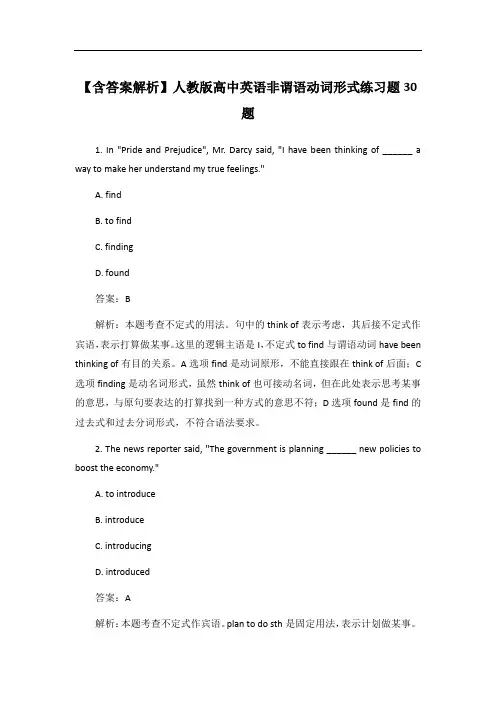
【含答案解析】人教版高中英语非谓语动词形式练习题30题1. In "Pride and Prejudice", Mr. Darcy said, "I have been thinking of ______ a way to make her understand my true feelings."A. findB. to findC. findingD. found答案:B解析:本题考查不定式的用法。
句中的think of表示考虑,其后接不定式作宾语,表示打算做某事。
这里的逻辑主语是I,不定式to find与谓语动词have been thinking of有目的关系。
A选项find是动词原形,不能直接跟在think of后面;C 选项finding是动名词形式,虽然think of也可接动名词,但在此处表示思考某事的意思,与原句要表达的打算找到一种方式的意思不符;D选项found是find的过去式和过去分词形式,不符合语法要求。
2. The news reporter said, "The government is planning ______ new policies to boost the economy."A. to introduceB. introduceC. introducingD. introduced答案:A解析:本题考查不定式作宾语。
plan to do sth是固定用法,表示计划做某事。
逻辑主语是the government,不定式to introduce与谓语动词is planning有目的关系。
B选项introduce是动词原形,不能直接用在plan后面;C选项introducing 是动名词形式,不符合plan的用法;D选项introduced是过去式和过去分词形式,在这里不符合语法规则。
3. In the movie "The Godfather", Michael said, "I don't want ______ involved in this family business at first."A. to getB. getC. gettingD. got答案:A解析:本题考查不定式作宾语。
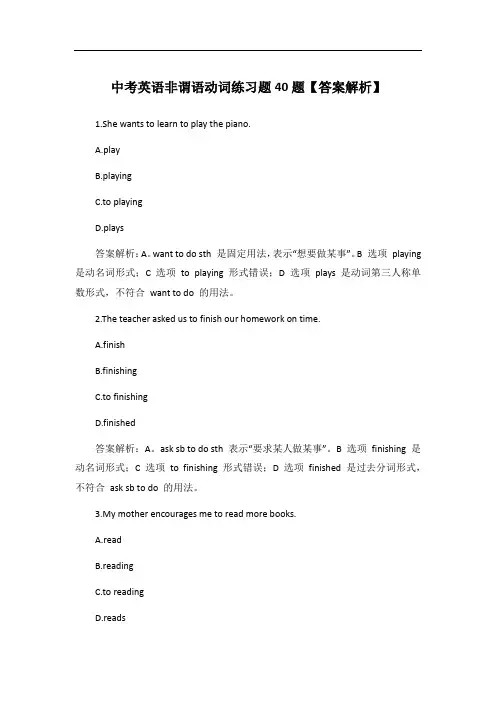
中考英语非谓语动词练习题40题【答案解析】1.She wants to learn to play the piano.A.playB.playingC.to playingD.plays答案解析:A。
want to do sth 是固定用法,表示“想要做某事”。
B 选项playing 是动名词形式;C 选项to playing 形式错误;D 选项plays 是动词第三人称单数形式,不符合want to do 的用法。
2.The teacher asked us to finish our homework on time.A.finishB.finishingC.to finishingD.finished答案解析:A。
ask sb to do sth 表示“要求某人做某事”。
B 选项finishing 是动名词形式;C 选项to finishing 形式错误;D 选项finished 是过去分词形式,不符合ask sb to do 的用法。
3.My mother encourages me to read more books.A.readB.readingC.to readingD.reads答案解析:A。
encourage sb to do sth 表示“鼓励某人做某事”。
B 选项reading 是动名词形式;C 选项to reading 形式错误;D 选项reads 是动词第三人称单数形式,不符合encourage sb to do 的用法。
4.I need to study hard to get good grades.A.studyB.studyingC.to studyingD.studied答案解析:A。
need to do sth 表示“需要做某事”。
B 选项studying 是动名词形式;C 选项to studying 形式错误;D 选项studied 是过去分词形式,不符合need to do 的用法。
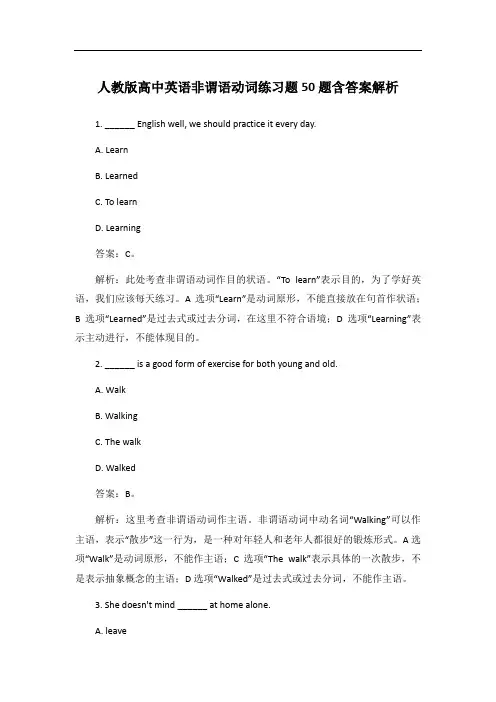
人教版高中英语非谓语动词练习题50题含答案解析1. ______ English well, we should practice it every day.A. LearnB. LearnedC. To learnD. Learning答案:C。
解析:此处考查非谓语动词作目的状语。
“To learn”表示目的,为了学好英语,我们应该每天练习。
A选项“Learn”是动词原形,不能直接放在句首作状语;B选项“Learned”是过去式或过去分词,在这里不符合语境;D选项“Learning”表示主动进行,不能体现目的。
2. ______ is a good form of exercise for both young and old.A. WalkB. WalkingC. The walkD. Walked答案:B。
解析:这里考查非谓语动词作主语。
非谓语动词中动名词“Walking”可以作主语,表示“散步”这一行为,是一种对年轻人和老年人都很好的锻炼形式。
A选项“Walk”是动词原形,不能作主语;C选项“The walk”表示具体的一次散步,不是表示抽象概念的主语;D选项“Walked”是过去式或过去分词,不能作主语。
3. She doesn't mind ______ at home alone.A. leaveB. to leaveC. being leftD. left答案:C。
解析:考查非谓语动词作宾语。
“mind”后面接动名词作宾语,这里表示她不介意被单独留在家里,是被动关系,所以用“being left”。
A选项“leave”是动词原形,不能作“mind”的宾语;B选项“to leave”是不定式,“mind”后不接不定式;D 选项“left”是过去式或过去分词,不能直接作“mind”的宾语。
4. I find it no use ______ to him. He doesn't listen.A. talkB. to talkC. talkingD. talked答案:C。
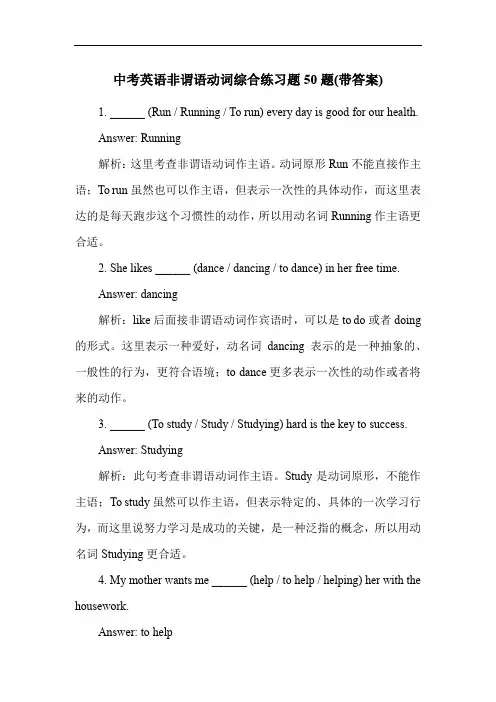
中考英语非谓语动词综合练习题50题(带答案)1. ______ (Run / Running / To run) every day is good for our health.Answer: Running解析:这里考查非谓语动词作主语。
动词原形Run不能直接作主语;To run虽然也可以作主语,但表示一次性的具体动作,而这里表达的是每天跑步这个习惯性的动作,所以用动名词Running作主语更合适。
2. She likes ______ (dance / dancing / to dance) in her free time.Answer: dancing解析:like后面接非谓语动词作宾语时,可以是to do或者doing 的形式。
这里表示一种爱好,动名词dancing表示的是一种抽象的、一般性的行为,更符合语境;to dance更多表示一次性的动作或者将来的动作。
3. ______ (To study / Study / Studying) hard is the key to success.Answer: Studying解析:此句考查非谓语动词作主语。
Study是动词原形,不能作主语;To study虽然可以作主语,但表示特定的、具体的一次学习行为,而这里说努力学习是成功的关键,是一种泛指的概念,所以用动名词Studying更合适。
4. My mother wants me ______ (help / to help / helping) her with the housework.Answer: to help解析:want sb. to do sth.是固定搭配,这里表示妈妈想要我去帮助她做家务,help是动词原形,不能直接用在want后面;helping也不符合这个结构。
5. The best way ______ (relax / to relax / relaxing) is to listen to music.Answer: to relax解析:这里考查非谓语动词作后置定语修饰way。
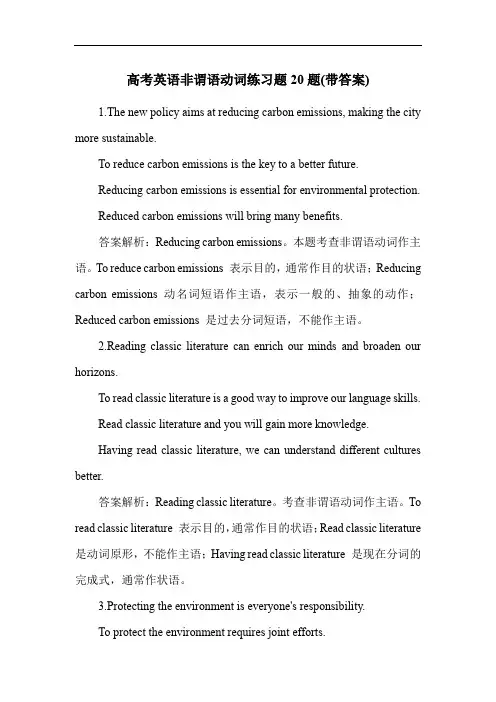
高考英语非谓语动词练习题20题(带答案)1.The new policy aims at reducing carbon emissions, making the city more sustainable.To reduce carbon emissions is the key to a better future.Reducing carbon emissions is essential for environmental protection.Reduced carbon emissions will bring many benefits.答案解析:Reducing carbon emissions。
本题考查非谓语动词作主语。
To reduce carbon emissions 表示目的,通常作目的状语;Reducing carbon emissions 动名词短语作主语,表示一般的、抽象的动作;Reduced carbon emissions 是过去分词短语,不能作主语。
2.Reading classic literature can enrich our minds and broaden our horizons.To read classic literature is a good way to improve our language skills.Read classic literature and you will gain more knowledge.Having read classic literature, we can understand different cultures better.答案解析:Reading classic literature。
考查非谓语动词作主语。
To read classic literature 表示目的,通常作目的状语;Read classic literature 是动词原形,不能作主语;Having read classic literature 是现在分词的完成式,通常作状语。
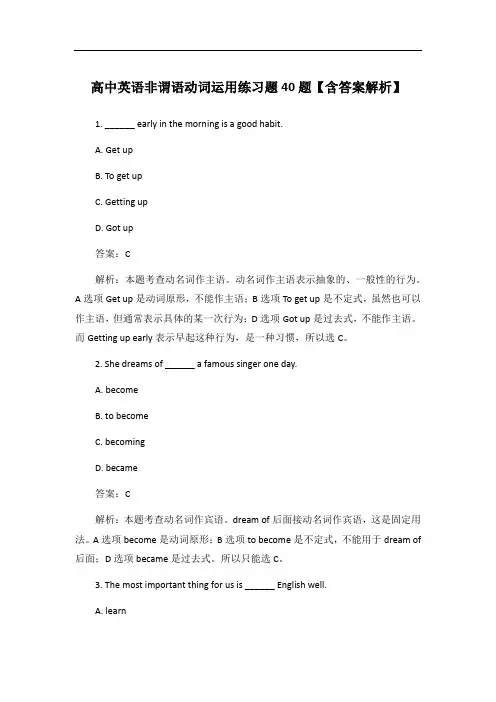
高中英语非谓语动词运用练习题40题【含答案解析】1. ______ early in the morning is a good habit.A. Get upB. To get upC. Getting upD. Got up答案:C解析:本题考查动名词作主语。
动名词作主语表示抽象的、一般性的行为。
A选项Get up是动词原形,不能作主语;B选项To get up是不定式,虽然也可以作主语,但通常表示具体的某一次行为;D选项Got up是过去式,不能作主语。
而Getting up early表示早起这种行为,是一种习惯,所以选C。
2. She dreams of ______ a famous singer one day.A. becomeB. to becomeC. becomingD. became答案:C解析:本题考查动名词作宾语。
dream of后面接动名词作宾语,这是固定用法。
A选项become是动词原形;B选项to become是不定式,不能用于dream of 后面;D选项became是过去式。
所以只能选C。
3. The most important thing for us is ______ English well.A. learnB. to learnC. learningD. learned答案:B解析:本题考查不定式作表语。
当主语部分有形容词最高级等修饰时,表语常用不定式。
A选项learn是动词原形;C选项learning是动名词;D选项learned 是过去式或过去分词,都不符合要求,所以选B。
4. I find it difficult ______ the problem by myself.A. solveB. to solveC. solvingD. solved答案:B解析:本题考查不定式作宾语。
在find + it + 形容词+ 不定式这种结构中,it是形式宾语,真正的宾语是后面的不定式。
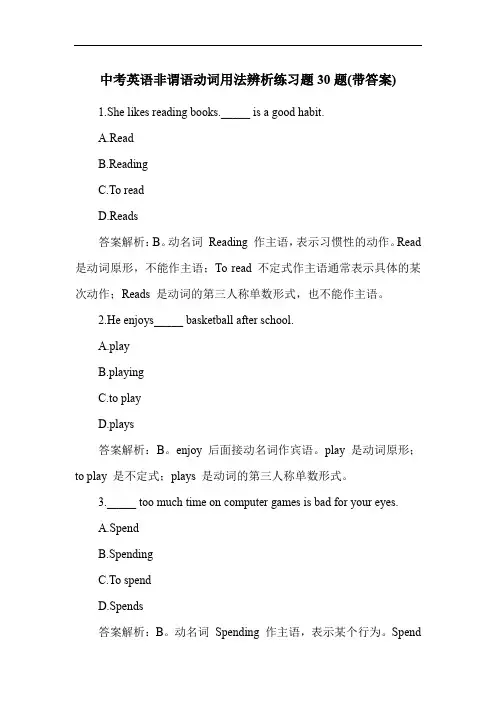
中考英语非谓语动词用法辨析练习题30题(带答案)1.She likes reading books._____ is a good habit.A.ReadB.ReadingC.To readD.Reads答案解析:B。
动名词Reading 作主语,表示习惯性的动作。
Read 是动词原形,不能作主语;To read 不定式作主语通常表示具体的某次动作;Reads 是动词的第三人称单数形式,也不能作主语。
2.He enjoys_____ basketball after school.A.playB.playingC.to playD.plays答案解析:B。
enjoy 后面接动名词作宾语。
play 是动词原形;to play 是不定式;plays 是动词的第三人称单数形式。
3._____ too much time on computer games is bad for your eyes.A.SpendB.SpendingC.To spendD.Spends答案解析:B。
动名词Spending 作主语,表示某个行为。
Spend是动词原形不能作主语;To spend 不定式作主语通常表示具体的某次动作;Spends 是动词的第三人称单数形式不能作主语。
4.My hobby is_____ stamps.A.collectB.collectingC.to collectD.collects答案解析:B。
动名词collecting 作表语,表示爱好。
collect 是动词原形;to collect 不定式作表语通常表示具体的某次动作或目的;collects 是动词的第三人称单数形式。
5.She wants_____ a movie tonight.A.seeB.seeingC.to seeD.sees答案解析:C。
want 后面接不定式作宾语。
see 是动词原形不能直接放在want 后面;seeing 动名词不能和want 搭配;sees 是动词的第三人称单数形式。
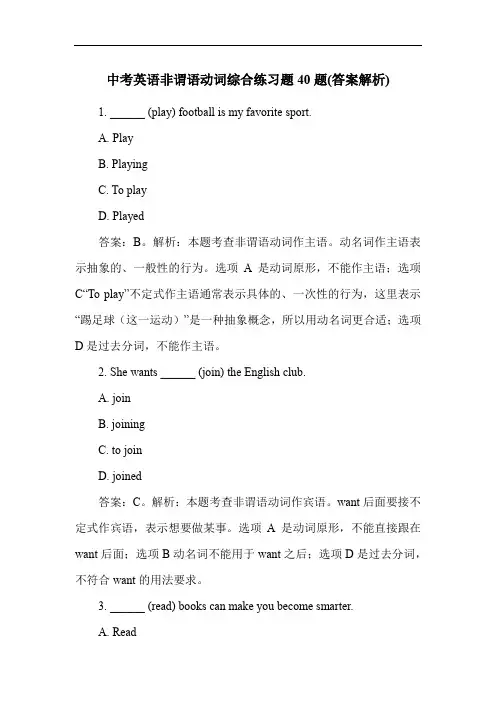
中考英语非谓语动词综合练习题40题(答案解析)1. ______ (play) football is my favorite sport.A. PlayB. PlayingC. To playD. Played答案:B。
解析:本题考查非谓语动词作主语。
动名词作主语表示抽象的、一般性的行为。
选项A是动词原形,不能作主语;选项C“To play”不定式作主语通常表示具体的、一次性的行为,这里表示“踢足球(这一运动)”是一种抽象概念,所以用动名词更合适;选项D是过去分词,不能作主语。
2. She wants ______ (join) the English club.A. joinB. joiningC. to joinD. joined答案:C。
解析:本题考查非谓语动词作宾语。
want后面要接不定式作宾语,表示想要做某事。
选项A是动词原形,不能直接跟在want后面;选项B动名词不能用于want之后;选项D是过去分词,不符合want的用法要求。
3. ______ (read) books can make you become smarter.A. ReadB. ReadingC. To readD. Readed答案:B。
解析:这里考查非谓语动词作主语。
动名词作主语表示经常的、习惯性的动作。
选项A是动词原形,不能作主语;选项C 不定式作主语多表示具体的、一次性的动作,这里说读书使你变得更聪明是一种普遍的情况,用动名词更好;选项D“readed”是错误形式。
4. He enjoys ______ (listen) to music in his free time.A. listenB. listeningC. to listenD. listened答案:B。
解析:本题考查非谓语动词作宾语。
enjoy后面接动名词作宾语,表示喜欢做某事。
选项A是动词原形,不能用在enjoy后面;选项C不定式不符合enjoy的用法;选项D是过去分词,也不能用于此处。
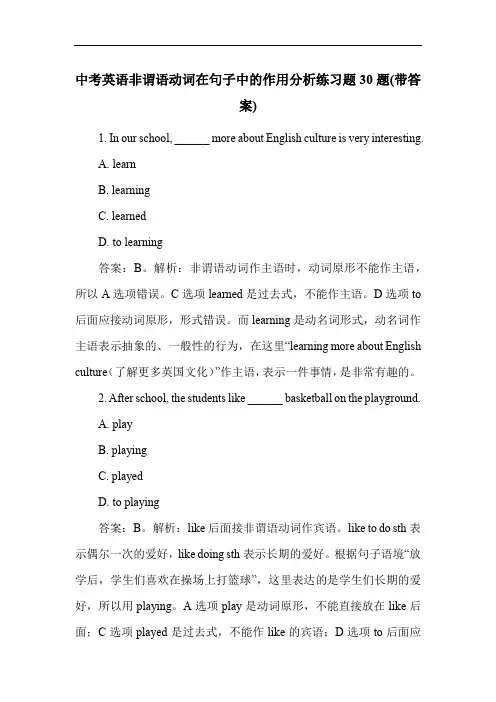
中考英语非谓语动词在句子中的作用分析练习题30题(带答案)1. In our school, ______ more about English culture is very interesting.A. learnB. learningC. learnedD. to learning答案:B。
解析:非谓语动词作主语时,动词原形不能作主语,所以A选项错误。
C选项learned是过去式,不能作主语。
D选项to 后面应接动词原形,形式错误。
而learning是动名词形式,动名词作主语表示抽象的、一般性的行为,在这里“learning more about English culture( 了解更多英国文化)”作主语,表示一件事情,是非常有趣的。
2. After school, the students like ______ basketball on the playground.A. playB. playingC. playedD. to playing答案:B。
解析:like后面接非谓语动词作宾语。
like to do sth表示偶尔一次的爱好,like doing sth表示长期的爱好。
根据句子语境“放学后,学生们喜欢在操场上打篮球”,这里表达的是学生们长期的爱好,所以用playing。
A选项play是动词原形,不能直接放在like后面;C选项played是过去式,不能作like的宾语;D选项to后面应接动词原形,形式错误。
3. ______ in the school choir makes me feel happy.A. SingB. SingingC. SangD. To sang答案:B。
解析:这里需要一个非谓语动词作主语。
A选项Sing 是动词原形,不能作主语;C选项Sang是过去式,不能作主语;D选项To后面应接动词原形sing,形式错误。
而Singing是动名词形式,动名词作主语表示一种行为,“在学校合唱团唱歌使我感到快乐”。
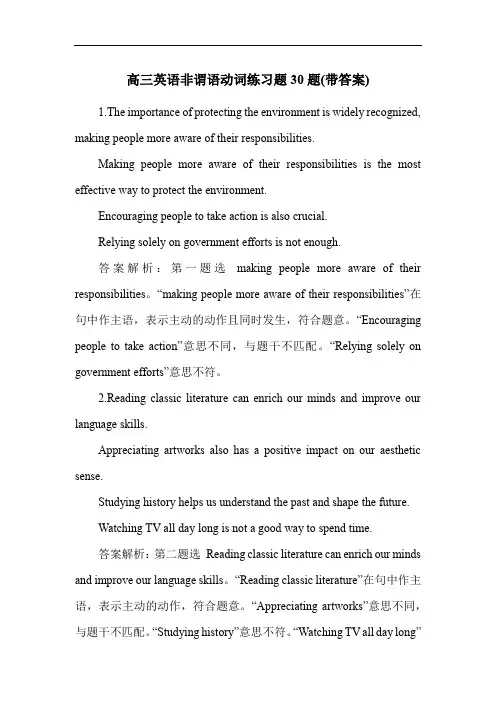
高三英语非谓语动词练习题30题(带答案)1.The importance of protecting the environment is widely recognized, making people more aware of their responsibilities.Making people more aware of their responsibilities is the most effective way to protect the environment.Encouraging people to take action is also crucial.Relying solely on government efforts is not enough.答案解析:第一题选making people more aware of their responsibilities。
“making people more aware of their responsibilities”在句中作主语,表示主动的动作且同时发生,符合题意。
“Encouraging people to take action”意思不同,与题干不匹配。
“Relying solely on government efforts”意思不符。
2.Reading classic literature can enrich our minds and improve our language skills.Appreciating artworks also has a positive impact on our aesthetic sense.Studying history helps us understand the past and shape the future.Watching TV all day long is not a good way to spend time.答案解析:第二题选Reading classic literature can enrich our minds and improve our language skills。
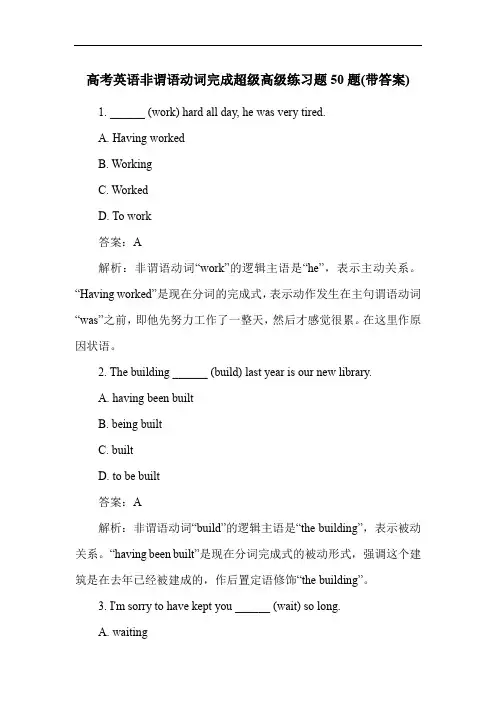
高考英语非谓语动词完成超级高级练习题50题(带答案)1. ______ (work) hard all day, he was very tired.A. Having workedB. WorkingC. WorkedD. To work答案:A解析:非谓语动词“work”的逻辑主语是“he”,表示主动关系。
“Having worked”是现在分词的完成式,表示动作发生在主句谓语动词“was”之前,即他先努力工作了一整天,然后才感觉很累。
在这里作原因状语。
2. The building ______ (build) last year is our new library.A. having been builtB. being builtC. builtD. to be built答案:A解析:非谓语动词“build”的逻辑主语是“the building”,表示被动关系。
“having been built”是现在分词完成式的被动形式,强调这个建筑是在去年已经被建成的,作后置定语修饰“the building”。
3. I'm sorry to have kept you ______ (wait) so long.A. waitingC. waitedD. having waited答案:A解析:非谓语动词“wait”的逻辑主语是“you”,表示主动关系。
“have kept you waiting”是使役动词keep的用法,“waiting”是现在分词作宾语补足语,表示让某人一直处于等待的状态,这里的“to have kept”表示这个动作已经发生。
4. ______ (finish) his homework, he went out to play.A. Having finishedB. FinishedC. To finishD. Finishing答案:A解析:非谓语动词“finish”的逻辑主语是“he”,表示主动关系。
人教版高中英语非谓语动词形式练习题30题含答案解析1. ______ (read) English novels is a good way to improve vocabulary.A. ReadB. ReadingC. To readingD. Reads答案解析:B。
在这个句子中,需要一个词作主语,表示“阅读英语小说”这个动作或行为。
非谓语动词中,动名词(reading)和不定式to read)都可以作主语。
选项A是动词原形,不能作主语;选项C 形式错误,没有“to reading”这种用法;选项D是动词的第三人称单数形式,也不能作主语。
而动名词reading在这里表示泛指的“阅读”这个行为,是正确的。
2. She dreams of ______ (become) a famous singer one day.A. becomeB. becameC. becomingD. to become答案解析:C。
dream of是固定短语,其中of是介词,后面要接动名词作宾语。
选项A是动词原形,不能跟在介词后面;选项B是动词的过去式,不符合要求;选项D是不定式,虽然不定式也可以表示将来等意义,但在这里根据短语搭配,要使用动名词becoming。
3. ______ (travel) around the world is his life - long dream.B. To travelC. TraveledD. Traveling答案解析:D。
这里考查非谓语动词作主语。
动名词traveling和不定式to travel都可以作主语,但是动名词表示一般性、抽象性的动作,不定式更多表示具体的、一次性的动作。
这里“环游世界”是一种抽象的概念,用动名词traveling更合适。
选项A是动词原形,不能作主语;选项C是动词的过去式,不能作主语。
4. He doesn't like ______ (laugh) at in public.A. to be laughedB. being laughedC. to laughD. laugh答案解析:B。
高三英语非谓语动词练习题40题(答案解析)1.The new movie, attracting a large audience, shows the power of friendship. The main plot revolves around two friends who go on an adventure. What really makes the movie stand out is its beautiful cinematography and engaging story.- attracting- attracted- to attract- attract答案解析:attracting。
现在分词attracting 在这里作定语,修饰movie,表示主动关系,即电影吸引观众。
attracted 表示被动关系,不符合语境;to attract 是不定式,表示目的或将来,也不合适;attract 是动词原形,不能直接作定语。
2.Reading books is one of my favorite hobbies. It broadens my horizons and enriches my knowledge.- Reading- Read- To read- Reads答案解析:Reading。
动名词Reading 在这里作主语,表示一种行为或活动。
Read 是动词原形,不能直接作主语;To read 是不定式,作主语时通常表示特定的目的或动作;Reads 是第三人称单数形式,不能作主语。
3.I enjoy listening to music. It helps me relax after a long day.- listening- listen- to listen- listens答案解析:listening。
动名词listening 作宾语,enjoy 后面接动名词作宾语。
英语非谓语动词练习题含答案一、非谓语动词1.Mr.Zhou is good at cooking and he has decided______his own restaurant.A.openB.openedC.to openD.opening【答案】C【解析】【分析】句意:周先生擅长烹饪,他已经决定开一家自己的餐馆。
搭配:decide to do sth.决定做某事;故答案为C。
【点评】考查动词不定式,牢记固定搭配。
2.一What should we take when going birdwatching?一We should take a pair of binoculars ____________the birds clearly.A.seeB.seeingC.to seeD.sees【答案】C【解析】【分析】句意:一去看鸟应该带什么?一为了看得清楚,我们应该带一副望远镜。
带上望远镜的目的是看得清楚,用带to的不定式作目的状语。
故选C。
3.My parents didn't allow me______to the party.A.goB.to goC.goesD.went【答案】B【解析】【分析】:本题考点为非谓语动词(固定用法)。
allow sb.to do sth.,即“允许某人做某事”。
故答案为B。
4.—Have you ever heard that China is building a nationwide5G network?—Right.5G will allow us________English movies faster than ever.A.downloadB.downloadsC.to downloadD.downloading【答案】C【解析】【分析】句意——你听说了中国正在建造全国5G网络吗?——对,5G将会让我们比原来更快的速度下载英文电影。
英语非谓语动词练习题及答案 一、单项选择非谓语动词 1.________ the difficult maths problem, I have consulted Professor Russell several times. A.Working out B.Worked out C.To work out D.Work out 【答案】C 【解析】 试题分析:考查非谓语动词的用法。句意:为了解出那道数学难题,我已经向Russell教授咨询过好几次了。非谓语动词中只有不定式可作目的状语,题干中缺少目的状语,故选C。
【知识拓展】不定式在句子中可作什么状语? 1)目的状语。To… only to (仅仅为了), in order to, so as to, so(such)… as to… (如此……以便……) 如:He ran so fast as to catch the first bus. 他飞快地跑以便赶上第一班车。I come here only to say good-bye to you. 我来仅仅是向你告别。
2)作结果状语,表事先没有预料到的,要放在句子后面。如:What have I said to make you angry?我说什么让您生气了?He searched the room only to find nothing.他搜查了房间什么
也没找到。 3) 表原因。如:I'm sorry to hear your father is ill听说你父亲病了很难过。
考点:考查非谓语动词的用法。 【名师点睛】本题考查不定式作目的状语。本题与2014年四川卷第7题相似— Good idea.To find more about it, visit this website.这里是动词不定式形式的非谓语动词做目的状
语。 非谓语动词是高考的重要考点。一般现在分词表示主动的关系,而过去分词表示被动的关系,动词不定式的用法很多,通常是跟在一个动词后面形成的固定结构,能够分辨出具体试题中的关系就可以轻松解题。
2.Be careful when you deal with this chemical, as it will explode when ______ to sunlight. A.exposed B.to expose C.exposing D.being exposed 【答案】A 【解析】 试题分析:考查非谓语动词。本题考查短语be exposed to暴露与……。句意:处理这种化学物质时要小心,因为它暴露在阳光下时会爆炸。故A正确。 考点:考查非谓语动词
3.John always gets up early in the morning _____ energetic and ready to start a new day. A.feel B.to feel C.feeling D.felt 【答案】C 【解析】考查现在分词。句意:John总是一大早起床,感觉精力充沛并准备开始新的一天。现在分词做伴随状态。故选C。
4.127.Everything ______ into due consideration, she eventually decided to further her education at home. A.having taken B.to be taken C.being taken D.taken 【答案】D 【解析】考查过去分词的独立主格结构。句意:考虑到一切,她最终决定继续在家接受教育。因为本题逗号前后没有连词,所以逗号前面不能是句子。故使用独立主格结构。因为everything与take into consideration构成被动关系,故使用过去分词的形式。故D正确。
【名师点睛】独立主格结构可以与状语从句互换。本句="After" everything was taken into consideration. 独立主格结构,是由“名词或代词+现在分词、过去分词、不定式、形容词短语、名词短语、介词短语或副词短语”构成的一种独立结构。在该结构中,名词或代词与其后的部分构成逻辑上的主谓关系,用来修饰谓语动词或整个句子。在句中作状语,表示“时间、条件、原因、伴随,方式或结果”等含义。其位置比较灵活,放于句首句末均可。 1. 名词(代词)+现在分词
The clock striking twelve, I went to bed.(表原因)
2. 名词(代词)+过去分词
He lay there on his back, his teeth set, his right hand clenched on his breast.(表伴随)
3. 名词(代词)+不定式
Here are the first three volumes, the fourth one to come out next month.(表伴随)
4. 名词(代词)+形容词短语
Her face pale with anger, she rose to go away.(表原因)
5. 名词(代词)+介词短语
Then, last night, I followed him here and climbed in, sword in hand.(表方式)
6. 名词(代词)+副词短语
Summer over, the students returned to school.(表原因)
7. 名词(代词)+名词短语
His first shot a failure, Tom fired again.(表原因)
5.There have been many advances in medicine in recent years. That means money ______ for medical research has been well spent. A.used B.using C.to use D.to be used 【答案】A 【解析】 【详解】 考查过去分词。句意:近年来医学取得了许多进展。这意味着用于医学研究的钱花得很值。分析句子可知,money与use在逻辑上是被动关系,所以用过去分词作后置定语。故选A项。 6.Mrs. White showed her students some old maps ________ from the library A.to borrow B.borrowed C.to be borrowed D.borrowing 【答案】B 【解析】 【详解】 考查非谓语动词。句意:怀特抬头给学生看一些从图书馆借来的旧地图。分析句子可知,这里需要非谓语动词修饰maps,因为maps和borrow是被动关系吗,所以用过去分词做定语,故选B。
7.________ nearly all our money, we couldn't afford to stay at a hotel. A.Having spent B.To spend C.Spent D.To have spent 【答案】A 【解析】 【详解】 考查非谓语动词。句意:已经花完了几乎所有的钱,我们无法支付住宾馆的费用。动词不定式表将来和目的,根据句意可知,“花钱”的动作发生在过去,排除B、D;过去分词表完成和被动,we与spend是主谓关系,应该用现在分词,排除C;当两个动作有先后关系时,用现在分词的完成式,现在分词的完成式在本句相当于because we have spent nearly all our money,表原因。故选A。
8.Jenny hopes that Mr Smith will suggest a good way to have her written English ________ in a short period. A.improved B.improving C.to improve D.improve 【答案】A 【解析】 宾语written English与improve之间为动宾关系,故用过去分词作宾补。
9._______ the classroom for a whole afternoon, the monitor decided to have a rest. A.Having cleaned B.To clean C.Cleaned D.Clean 【答案】A 【解析】考查非谓语动词。句意:整个下午打扫了教室之后,班长决定休息一下。句中clean的动作比decided早,故用完成时;the monitor和clean是主动关系,此处作状语用
动词-ing形式,故此处用动词-ing形式的完成时,故选A。 10.When we saw the road ________ with snow, we decided to spend the holiday at home. A.block B.to block C.blocking D.blocked 【答案】D 【解析】 【详解】 考查非谓语动词。句意:当我们看到路上被雪覆盖时,我们决定在家里度假。此处用非谓语动词作宾补,动词block与see的宾语the road之间为被动关系,构成短语see sb/ sth done。故选D。
11."We can't go out in this weather, "said Bob, _____ out of the window. A.looking B.to look C.looked D.having looked 【答案】A 【解析】 【分析】 【详解】
考查现在分词做状语。句意:Bob看着窗外说:“这样的天气我们不能出去”。本句中look与said是同时进行,we与look之间构成主动关系,故用现在分词作伴随状语。故选A。
12.(福建) ___________the past year as an exchange student in Hong Kong, Linda appears more mature than those of her age. A.Spending B.Spent C.Having spent D.To spend 【答案】C 【解析】 试题分析:“花费”和其逻辑主语“Linda”之间是主动关系,故用现在分词作原因状语。且“花费”的动作明显早于“看起来成熟”这个动作。表示发生在谓语动作之前的动作,用现在分词的完成时。句意:由于Linda过去几年在香港作交换留学生,所以她看起来比她的实际年龄更成熟。 考点:考查非谓语动词的用法。